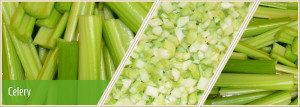The transfer of Listeria monocytogenes to previously uncontaminated product during mechanical dicing of celery and its growth during storage at various temperatures were evaluated. In each of three trials, 275 g of retail celery stalks was immersed in an aqueous five-strain L. monocytogenes cocktail to obtain an average of 5.6 log CFU/g and then was diced using a  hand-operated dicer, followed by sequential dicing of 15 identical 250-g batches of uninoculated celery using the same dicer. Each batch of diced celery was examined for numbers of Listeria initially and after 3 and 7 days of storage at 4, 7, and 10°C. Additionally, the percentage by weight of inoculated product transferred to each of 15 batches of uninoculated celery was determined using inoculated red stems of Swiss chard as a surrogate. Listeria transfer to diced celery was also assessed after removing the Swiss chard. L. monocytogenes transferred from the initial batch of inoculated celery to all 15 batches of uninoculated celery during dicing, with populations decreasing from 5.2 to 2.0 log CFU/g on the day of processing. At 10°C, Listeria reached an average population of 3.4 log CFU/g in all batches of uninoculated celery. Fewer batches of celery showed significant growth during storage at 4 and 7°C (P < 0.05). Swiss chard pieces were recovered from all 15 batches of celery, with similar amounts seen in batches 2 to 15 (P > 0.05). L. monocytogenes was also recovered from each batch of uninoculated celery after the removal of Swiss chard, with populations decreasing from 4.7 to 1.7 log CFU/g. Storing the diced celery at 10°C yielded a L. monocytogenes generation time of 0.87 days, with no significant growth observed during storage at 4 or 7°C. Consequently, mitigation strategies during dicing and proper refrigeration are essential to minimizing potential health risks associated with diced celery.
hand-operated dicer, followed by sequential dicing of 15 identical 250-g batches of uninoculated celery using the same dicer. Each batch of diced celery was examined for numbers of Listeria initially and after 3 and 7 days of storage at 4, 7, and 10°C. Additionally, the percentage by weight of inoculated product transferred to each of 15 batches of uninoculated celery was determined using inoculated red stems of Swiss chard as a surrogate. Listeria transfer to diced celery was also assessed after removing the Swiss chard. L. monocytogenes transferred from the initial batch of inoculated celery to all 15 batches of uninoculated celery during dicing, with populations decreasing from 5.2 to 2.0 log CFU/g on the day of processing. At 10°C, Listeria reached an average population of 3.4 log CFU/g in all batches of uninoculated celery. Fewer batches of celery showed significant growth during storage at 4 and 7°C (P < 0.05). Swiss chard pieces were recovered from all 15 batches of celery, with similar amounts seen in batches 2 to 15 (P > 0.05). L. monocytogenes was also recovered from each batch of uninoculated celery after the removal of Swiss chard, with populations decreasing from 4.7 to 1.7 log CFU/g. Storing the diced celery at 10°C yielded a L. monocytogenes generation time of 0.87 days, with no significant growth observed during storage at 4 or 7°C. Consequently, mitigation strategies during dicing and proper refrigeration are essential to minimizing potential health risks associated with diced celery.
Journal of Food Protection®, Number 5, May 2014, pp. 696-863 , pp. 765-771(7)
Kaminski, Chelsea N.1; Davidson, Gordon R.2; Ryser, Elliot T.3
